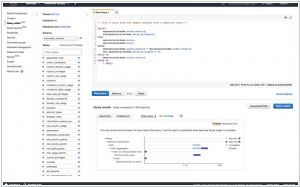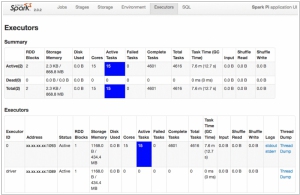Amazon Redshift vs Apache Spark
March 19, 2025 | Author: Michael Stromann
12★
Amazon Redshift is a fast, fully managed, petabyte-scale data warehouse service that makes it simple and cost-effective to efficiently analyze all your data using your existing business intelligence tools. You can start small for just $0.25 per hour with no commitments or upfront costs and scale to a petabyte or more for $1,000 per terabyte per year, less than a tenth of most other data warehousing solutions.
17★
Apache Spark is a fast and general engine for large-scale data processing. Run programs up to 100x faster than Hadoop MapReduce in memory, or 10x faster on disk. Write applications quickly in Java, Scala or Python. Combine SQL, streaming, and complex analytics.
See also:
Top 10 Big Data platforms
Top 10 Big Data platforms
Amazon Redshift and Apache Spark are both highly sophisticated, incredibly advanced, and—most importantly—capable of making sense of the vast, incomprehensible amounts of data that humans insist on generating. They let people write SQL queries (which is, of course, the universal way of asking computers deeply philosophical questions like "How much money did we lose last quarter?"). Both of them distribute data processing across multiple machines, which sounds a lot like teamwork until you realize that none of the machines actually like each other. They also integrate seamlessly with various cloud services, meaning they are both slightly less prone to existential crises when placed in AWS.
Redshift, designed by Amazon in 2012, is what happens when someone looks at a traditional data warehouse and says, "Wouldn’t it be nice if this were faster and didn't require quite so many sacrificial IT personnel?" It uses columnar storage, which, to the untrained eye, sounds like a fancy way of stacking things vertically, but actually makes queries much faster. Redshift is great at handling structured data, but not so great at real-time anything—if you ask it a question, it will get back to you when it's good and ready. The real beauty of Redshift is that it’s fully managed, meaning Amazon takes care of the messy bits while you sip your coffee and pretend to know what “performance optimization” means.
Meanwhile, Apache Spark, born in 2014 from the fevered minds at UC Berkeley, is more of a reckless genius than a stable, well-mannered warehouse. It thrives on in-memory computing, which means it processes data faster but also tends to demand large amounts of RAM with the same casual entitlement as a teenager raiding the fridge. It’s incredibly flexible, supporting multiple programming languages and it doesn’t particularly care where its data lives—HDFS, S3, Kafka, Cassandra or some long-lost hard drive under your desk. Unlike Redshift, Spark loves real-time processing and machine learning, making it the perfect choice for those who like their analytics with a side of mild chaos.
See also: Top 10 Big Data platforms
Redshift, designed by Amazon in 2012, is what happens when someone looks at a traditional data warehouse and says, "Wouldn’t it be nice if this were faster and didn't require quite so many sacrificial IT personnel?" It uses columnar storage, which, to the untrained eye, sounds like a fancy way of stacking things vertically, but actually makes queries much faster. Redshift is great at handling structured data, but not so great at real-time anything—if you ask it a question, it will get back to you when it's good and ready. The real beauty of Redshift is that it’s fully managed, meaning Amazon takes care of the messy bits while you sip your coffee and pretend to know what “performance optimization” means.
Meanwhile, Apache Spark, born in 2014 from the fevered minds at UC Berkeley, is more of a reckless genius than a stable, well-mannered warehouse. It thrives on in-memory computing, which means it processes data faster but also tends to demand large amounts of RAM with the same casual entitlement as a teenager raiding the fridge. It’s incredibly flexible, supporting multiple programming languages and it doesn’t particularly care where its data lives—HDFS, S3, Kafka, Cassandra or some long-lost hard drive under your desk. Unlike Redshift, Spark loves real-time processing and machine learning, making it the perfect choice for those who like their analytics with a side of mild chaos.
See also: Top 10 Big Data platforms





